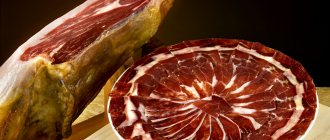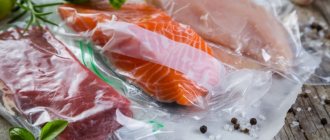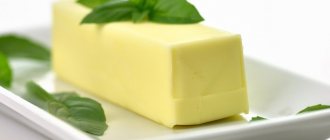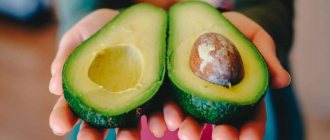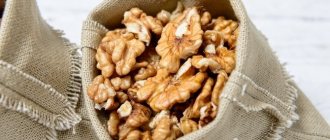Every housewife thinks about how to preserve food for as long as possible without spoiling or losing its beneficial properties.
Vacuum food storage comes to the rescue. The word “vacuum” itself is translated from Latin as “emptiness”. In other words, vacuuming creates a space in which there is no air. When it comes to food, oxygen is removed from special bags or containers. The absence of oxygen prevents the process of harmful oxidation reactions and the formation of bacteria and fungi.
That is, the absence of air leads to the absence of factors that affect and spoil products. Thus, pumping out air from the place where food is stored helps prevent spoilage and keep it fresh and healthy for as long as possible.
PA/PE and OPA/PE
(polyamide/high density polyethylene and oriented polyamide)
Thickness 15-20 microns + 2-3 microns of adhesive (gluing layer) + PE. This is a mid-barrier barrier layer.
Good barrier to oxygen and most gases. Packaging: frozen products (fish, meat, semi-finished products, vegetables, fruits, etc.) with longer storage, gourmet products (cuts and whole pieces), banknotes in banks, medical devices and drugs. When packaging frozen and refrigerated products, the shelf life is up to 30 days*.
General information
To vacuum food at home, you can use a vacuum container or a special device - a household vacuum sealer. What are the advantages of vacuum food storage?
The main ones include:
- Keeping food fresh for a long time, in some cases, even without storing it in the refrigerator;
- Isolation from foreign odors present in storage areas;
- Preservation of beneficial properties;
- Save space in the refrigerator and freezer.
In addition to the obvious advantages, this process allows you to significantly save money. Since it is possible to preserve vegetables and fruits purchased in the summer in this way and use them in food during the cold season, their price in stores and markets is much higher.
Applications and consumption segments
- HoReCa (canteens, cafes, restaurants, fast food, pit stop)
Preparation and storage of semi-finished products, long-term refrigerated storage, transportation to the point of sale.
- Manufacturing plants
Packaging of frozen semi-finished products (berries, vegetables, wild plants), packaging of cheeses, delicacies, salads, sale of chilled products.
Culinary shop (preparation of pickled, snack products) Packing of ready-to-eat dishes after heating, boiled vegetables, snacks.
- Trading companies
Packaging of sweets, semi-finished products, cheeses, frozen products, transportation to the point of sale.
- Stores of manufactured goods and building materials
Packaging of small spare parts, transportation.
Types of packaging
Due to the fact that more and more housewives are beginning to store food in this way at home, manufacturers offer a large selection of special vacuum packaging: containers and bags of various shapes, sizes and even colors. All of them are sold complete with a pump, which is necessary to remove all the air from the package. On some models, the pump may be built into the lid.
- Vacuum storage containers are the most popular . They are made of plastic or heat-resistant glass, which allows them to be used in the microwave, for example, when defrosting stored meat. Additionally, some models are equipped with a built-in calendar that allows you to set the storage start date. You can buy such containers at most supermarkets or specialty kitchenware stores. They are not cheap, especially those made from high-quality materials, but their price is fully compensated by the advantages.
- You can also quite often find vacuum bags for storing food . They can be either disposable, requiring the use of a vacuum sealer, or reusable with a special valve to remove air.
Methods for storing apples
It is considered optimal to place them in boxes in 2–3 layers, since in this case it is easier to detect rotting fruit and remove it. There may be more layers, but this storage organization is used for late winter varieties with hard skin.
The stalks should look up and not rest against the fruits on top. If necessary, they can be shortened, but not completely pulled out.
Wrapping apples in paper
The paper can be plain or oiled (you can use Vaseline). Oil – olive or sunflower – helps retain moisture inside the fruit, since paper does not allow air to pass through well. If the cellar is dry, it is better to grease a piece of parchment with Vaseline and wait until it is saturated. Then wrap each apple and put it in boxes.
Wormy and rotten specimens will rot in oil paper, so it is better to throw them away.
Layering (spilling) apples
You can layer the fruits with the following substances:
- sawdust, but not pine sawdust;
- peat;
- sand or its mixture with wood ash;
- onion peel, buckwheat;
- shavings;
- moss
Apples should be kept at a distance from each other.
In plastic bags
Most often, apple harvests are stored in two ways - conventional and vacuum. Typically, 2–4 kg of fruit are placed in one bag and holes are made for ventilation. For the vacuum method, you need to have a special pump to remove air - these are now sold in supermarkets along with bags.
If you have a device for carbonating water, you can fill the bags with carbon dioxide and then seal them with a hot iron or a lit candle.
Easy installation
Simple storage of apples
It is also possible to store crops in bulk, but this method is not the most reliable. This is how apples are stored if they are being prepared for sale and there is an opportunity to sort them out frequently. This method is not recommended for your family.
Simple installation also means layer-by-layer without any pouring or wrapping.
Storing apples in sand
It is advisable to mix sand with ash, but before doing this it must be washed and dried well. Ash has an alkaline reaction, so it protects fruits well from rot - fungus. Lightly damp sand, no more than 5% water, is used to store apples in a cool, dry room.
What happens to the product over time?
Meat is a perishable product. Therefore, at the first sign of spoilage of this product, it is strictly prohibited to eat it. There are many criteria that help determine the freshness of meat products. Three of them are the main and simplest:
- Appearance. Good meat has a dark brown or bright pink color. There should be no inclusions of other shades. The only exceptions are light fat layers. If the fat has acquired a gray or red color, this piece is already spoiled. The same applies to the color of bones/joints - in fresh meat they are always white, a different shade indicates spoilage of the product.
- Smell. Know that fresh and excellent quality meat has practically no smell; only a subtle milky smell may be present. If other flavors are present, it is better to avoid consuming meat.
- Consistency. A good meat product is elastic and dense to the touch. If, when pressing with a finger, a dent forms on the meat surface and does not disappear for a long time, the meat has spoiled. The same is true for the stickiness and slipperiness of a piece of meat.
In the following video you can see how to choose fresh meat:
Classification of heat treatment of meat
Each type of heat treatment of meat has its own characteristics.
For example, it is considered paired within one and a half hours after the slaughter of the animal. It has a natural temperature and cools down over time. Due to the fact that the muscles are still very tense, it is quite rigid. In order for them to relax and the meat to acquire the necessary softness, you should wait several days. Chilled is the one that, after cutting the carcass, is put into the refrigerator and cools down there. The top is covered with a natural crust. The temperature of chilled meat does not exceed +4 degrees.
Frozen meat is different in that only the outer part is frozen; the inside remains unfrozen.
And in order for the meat to be stored longer and not spoil, withstanding long transportation, deep freezing is used.
What foods can be stored in a vacuum?
The list of such products is quite large. You can store meat, vegetables, cheeses, ready-made meals and then liquids in them.
It is worth considering the storage features of each of them:
- Raw meat and fish . It is advisable to pre-cool or freeze them for a few hours before packing them. This will help in retaining juice and shape. The shelf life of raw fish can thus increase from 3 to 9-10 days. If meat or fish is stored in a vacuum bag in the freezer, it can remain fresh for months or even a year.
ATTENTION! When placed in a vacuum, beef may brown due to lack of oxygen. But this does not mean that the meat has spoiled.
- Vegetables. Before putting them in a vacuum bag or container, preliminary short-term treatment with boiling water is required. This procedure is called blanching and allows you to preserve the smell, color and taste of products. Leafy vegetables and legumes require processing for 1-2 minutes, carrots - 5 minutes in boiling water, cereal plants - 10 minutes. After this, the vegetables must be cooled and dried, only then placed in a bag or container. The shelf life of vegetables in this form increases from 4-5 days to 3 weeks.
Besides the obvious solids, liquids can also be stored using special vacuum lids. In this way, you can extend the life of juices, compotes or vinegar.
- You can also store cooked foods , such as soups, cereals or casseroles. Their shelf life in a vacuum container increases significantly compared to conventional storage and reaches up to 2 weeks.
- bread is stored this way to enjoy its freshness for as long as possible. Using a vacuum bag allows you to preserve baked goods for 7-10 days.
Reviews about vacuum food storage are only positive. This is due to the fact that this method has a very large number of positive aspects. The negative thing is, perhaps, not the cheap price.
How to choose chilled meat
In order not to be mistaken with the quality of meat, you need to carefully consider its choice. Firstly, color is important. If the beef is too light, then this is a reason to be wary, as this is an indicator of the animal being too young. Such people are not allowed to be slaughtered without compelling reasons. Meat that is too dark, with a gray tint, indicates that it is not fresh. If chilled beef meat has yellow and dull fat, you should refuse such a purchase.
Fresh, high-quality meat has an elastic consistency and a shiny surface; moisture does not leak out of it, and there is no plaque on it.
To check this, you should take the piece in your hands and carefully examine it from all sides. Then you need to press your finger on the surface, if the resulting depression quickly disappears, then the meat has not been frozen. Thawed meat is characterized by looseness, the muscles are not elastic, and ichor may drip from it. Freshness will help determine the smell. It should not be harsh and unpleasant, causing negative emotions.
Remember, the older the cow, the more fatty layers there are in its meat. In a young individual they are barely noticeable.
With the right choice and compliance with all storage standards, it is possible to prepare a delicious dish using meat that will be safe for health and beneficial for the body.
Vacuum Technology
The vacuum sealing process, which can be compared to cold preservation, consists of the following steps:
- The product is placed in a special package. When vacuum sealing foods with a high moisture content, they are pre-cooled.
- Using special equipment, air is removed from the packaging.
- Sealing is carried out with a hermetically sealed seam using heat sealing.
For vacuum sealing, bags made of several layers of polymer films with high barrier characteristics are used, ensuring reliable storage of goods. They are characterized by:
- three-way secure seams;
- notches - for easy opening;
- convenient design.
Depending on the nature of the contents, choose models with a Zip-Lock, with Euro-suspension perforations, and doypacks, which are flexible packaging with a bottom.

